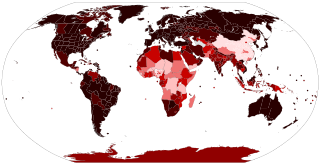The 2019–20 coronavirus pandemic is an ongoing global pandemic of coronavirus disease 2019 (COVID-19), caused by SARS-CoV-2 - wikipedia ![]()

2019–20 coronavirus pandemic. Pandemic of coronavirus disease
- wikimedia ![]()
The outbreak was first identified in Wuhan, Hubei, China, in December 2019, and was recognised as a pandemic by the World Health Organization (WHO) on 11 March 2020. As of 22 March, more than 335,000 cases of COVID-19 have been reported in over 190 countries and territories, resulting in more than 14,600 deaths and 97,000 recoveries.

Semi-log plot of coronavirus daily deaths by region comparing Hubei, rest of China, rest of world and world total
- wikimedia ![]()
The virus is typically spread from one person to another via respiratory droplets produced during coughing. It may also be spread from touching contaminated surfaces and then touching one's face. It is most contagious when people are symptomatic, although spread may be possible before symptoms appear.
The time between exposure and symptom onset is typically around five days, but may range from two to fourteen days. Common symptoms include fever, cough, and shortness of breath.
Complications may include pneumonia and acute respiratory distress syndrome. There is no vaccine or specific antiviral treatment.
Primary treatment is symptomatic and supportive therapy. Recommended preventive measures include hand washing, covering the mouth when coughing, maintaining distance from other people, and monitoring and self-isolation for people who suspect they are infected.
Efforts to prevent the virus spreading include travel restrictions, quarantines, curfews, event postponements and cancellations, and facility closures. These include: - a quarantine of Hubei - nationwide quarantines in Italy and elsewhere - curfew measures elsewhere in China and South Korea - various border closures or passenger restrictions - screening at airports and train stations, and - travel advisories regarding regions with community transmission
Schools and universities have closed either on a nationwide or local basis in over 124 countries, affecting more than 1.2 billion students.
The pandemic has led to global socioeconomic disruption, the postponement or cancellation of sporting, religious and cultural events, and widespread fears of supply shortages which have spurred panic buying.
Misinformation and conspiracy theories about the virus have spread online, and there have been incidents of xenophobia and racism against Chinese and other East or Southeast Asian people.
# See also